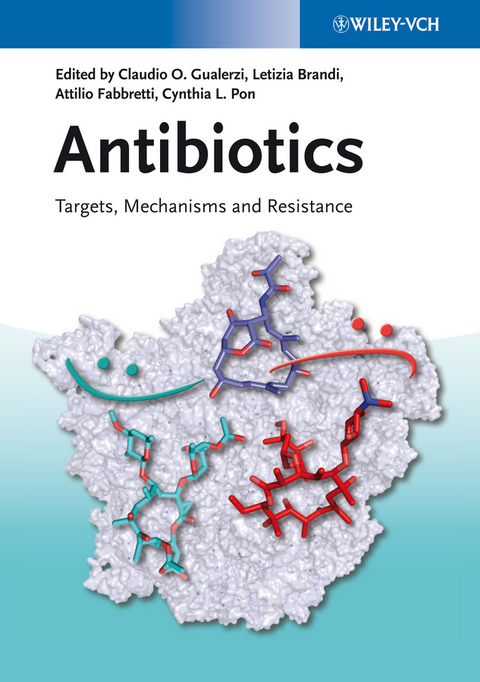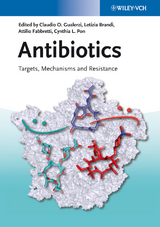Antibiotics
Wiley-VCH (Verlag)
978-3-527-33305-9 (ISBN)
- Titel ist leider vergriffen;
keine Neuauflage - Artikel merken
Claudio Gualerzi is full professor of Molecular Biology at the University of Camerino (Italy) and member of the EMBO. Following his studies at the University of Rome-La Sapienza and a postdoctoral period at the University of Pennsylvania (USA), he served as research group leader at the Max-Planck-Institute for Molecular Genetics in Berlin (Germany). He was consultant for the Lepetit Research Center in Gerenzano (Italy) and has received numerous awards and honorary lectureships, including the research prize of the Alexander von Humboldt foundation for his work on ribosome function and the discovery of novel antibiotics. Attilio Fabbretti completed his doctoral studies at the University of Camerino (Italy) where he is now a research associate in the laboratory of Molecular Biology. He received the prize of the Italian Society for General Microbiology and Microbial Biotechnology for the best PhD thesis in 2007. Letizia Brandi received her doctoral degree from the University of Catania after performing her thesis work at the University of Camerino, Italy. She served a postdoctoral period at the University of Montana (Missoula, USA) and worked as a senior scientist at Biosearch Italia, spa and Vicuron Pharmaceuticals (Gerenzano, Italy), before joining the laboratory of Molecular Biology at the University of Camerino where she is now a research associate. Cynthia Pon received her PhD from Rutgers the State University (USA). Following post-doctoral periods at the University of Pennsylvania and Hunter College of the City University of New York, she worked at the Max-Planck-Institute for Molecular Genetics in Berlin (Germany) before becoming full professor of Molecular and Microbial Genetics at the University of Camerino (Italy). Her work has focused on the mechanism of protein synthesis, global responses in bacteria and action of antibiotics.
Preface
A CHEMIST'S SURVEY OF DIFFERENT ANTIBIOTIC CLASSES
Introduction
Aminoglycosides
Beta-Lactams
Linear Peptides
Cyclic Peptides
Thiazolylpeptides
Macrolactones
Ansamycins-Rifamycins
Tetracyclines
Oxazolidinones
Lincosamides
Pleuromutilins
Quinolones
Aminocoumarins
ANTIBACTERIAL DISCOVERY: PROBLEMS AND POSSIBILITIES
Introduction
Why Is Antibacterial Discovery Difficult? The Problems
Target Choice: Essentiality
Target Choice: Resistance
Cell Entry
Screening Strategies
Natural Products
Computational Chemistry, Virtual Screening, Structure- and Fragment-Based Drug Design (SBDD and FBDD)
Conclusions
IMPACT OF MICROBIAL NATURAL PRODUCTS ON ANTIBACTERIAL DRUG DISCOVERY
Introduction
Natural Products for Drug Discovery
Microbial Natural Products
The Challenge of Finding Novel Antibiotics from New Natural Sources
Workflow for Drug Discovery from Microbial Natural Products
Antimicrobial Activities: Targets for Screens
Natural Products: A Continuing Source for Inspiration
Genome Mining in Natural Product Discovery
Conclusions
ANTIBIOTICS AND RESISTANCE: A FATAL ATTRACTION
To Be or Not To Be Resistant: Why and How Antibiotic Resistance Mechanisms Develop and Spread among Bacteria
Bacterial Resistance to Antibiotics by Enzymatic Degradation or Modification
Antibiotic Target Alteration: The Trick Exists and It Is in the Genetics
Efflux Systems
The Case Stories of Intrinsic and Acquired Resistances
Strategies to Overcome Resistance
FITNESS COSTS OF ANTIBIOTIC RESISTANCE
Introduction
Methods to Estimate Fitness
Factors Affecting Fitness
Mechanisms and Dynamics Causing Persistence of Chromosomal and Plasmid-Borne Resistance Determinants
INHIBITORS OF CELL-WALL SYNTHESIS
Introduction
MraY Inhibitors
Lipid II Targeting Compounds
Bactoprenol Phosphate
Conclusions
INHIBITORS OF BACTERIAL CELL PARTITIONING
Introduction
Bacterial Cell Division
Cell Division Proteins as Therapeutic Targets
Status of FtsZ-Targeting Compounds: From Laboratory to Clinic
Conclusion
THE MEMBRANE AS A NOVEL TARGET SITE FOR ANTIBIOTICS TO KILL PERSISTING BACTERIAL PATHOGENS
Introduction
The Challenge of Treating Dormant Infections
Discovery Strategies to Prevent or Kill Dormant Bacteria
Why Targeting the Membrane Could Be a Suitable Strategy
Target Essentiality and Selectivity
Multiple Modes of Actions
Therapeutic Use of Membrane-Damaging Agents against Biofilms
New Approaches to Identifying Compounds That Kill Dormant Bacteria
Challenges for Biofilm Control with Membrane-Active Agents
Potential for Membrane-Damaging Agents in TB Disease
Application to Treatment for Clostridium difficile Infection
Is Inhibition of Fatty Acid/Phospholipid Biosynthesis Also an Approach?
Concluding Remarks
BACTERIAL MEMBRANE, A KEY FOR CONTROLLING DRUG INFLUX AND EFFLUX
Introduction
The Mechanical Barrier
Circumventing the Bacterial Membrane Barrier
Conclusion
INTERFERENCE WITH BACTERIAL CELL-TO-CELL CHEMICAL SIGNALING IN DEVELOPMENT OF NEW ANTI-INFECTIVES
Introduction
Two-Component Systems (TCSs) as Potential Anti-Infective Targets
WalK/WalR and MtrB/MtrA: Case Studies of Essential TCSs as Drug Targets
Targeting Nonessential TCS
Non-TCSs Targeting Biofilm Formation and Quorum Sensing in Pseudomonas spp.
Conclusions
RECENT DEVELOPMENTS IN INHIBITORS OF BACTERIAL TYPE IIA TOPOISOMERASES
Introduction
DNA-Gate Inhibitors
ATPase-Domain Inhibitors
Simocyclinones, Gyramides, and Other Miscellaneous Inhibitors
Conclusions and Perspectives
ANTIBIOTICS TARGETING BACTERIAL RNA POLYMERASE
Introduction
Antibiotics Blocking Nascent RNA Extension
Antibiotics Targeting RNAP Active Center
Antibiotics Blocking Promoter Complex Formation
Inhibitors Hindering Sigma-Core Interactions
Inhibitors with Unknown Mechanisms and Binding Sites
Conclusions and Perspectives
INHIBITORS TARGETING RIBOSWITCHES AND RIBOZYMES
Introduction
Riboswitches as Antibacterial Drug Targets
Ribozymes as Antibacterial Drug Targets
Concluding Remarks and Future Perspectives
TARGETING RIBONUCLEASE P
Introduction
Targeting RNase P with Antisense Strategies
Aminoglycosides
Peptidyltransferase Inhibitors
Substrate Masking by Synthetic Inhibitors
Peculiar Behavior of Macrolides on Bacterial RNase P
Antipsoriatic Compounds
Conclusions and Future Perspectives
INVOLVEMENT OF RIBOSOME BIOGENESIS IN ANTIBIOTIC FUNCTION, ACQUIRED RESISTANCE, AND FUTURE OPPORTUNITIES IN DRUG DISCOVERY
Introduction
Ribosome Biogenesis
Methyltransferases
Methyltransferase Integration into the Ribosome Biogenesis Pathway
Ribosome Biogenesis Factors, Virulence, and Vaccine Development
AMINOACYL-Trna Synthetase Inhibitors
Introduction
Enzymatic Mechanism of Action of aaRS
aaRS Inhibitors
Considerations for the Development of aaRS Inhibitors
Conclusions
ANTIBIOTICS TARGETING TRANSLATION INITIATION IN PROKARYOTES
Introduction
Mechanism of Translation Initiation
Inhibitors of Folate Metabolism
Methionyl-tRNA Formyltransferase
Inhibitors of Peptide Deformylase
Inhibitors of Translation Initiation Factor IF2
ppGpp Analogs as Potential Translation Initiation Inhibitors
Translation Initiation Inhibitors Targeting the P-Site
INHIBITORS OF BACTERIAL ELONGATION FACTOR EF-Tu
Introduction
Enacyloxins
Kirromycin
Pulvomycin
GE2270A
AMINOGLYCOSIDE ANTIBIOTICS: STRUCTURAL DECODING OF INHIBITORS TARGETING THE RIBOSOMAL DECODING A SITE
Introduction
Chemical Structures of Aminoglycosides
Secondary Structures of the Target A Sites
Overview of the Molecular Recognition of Aminoglycosides by the Bacterial A Site
Role of Ring I: Specific Recognition of the Binding Pocket
Role of Ring II (2-DOS Ring): Locking the A-Site Switch in the "On" State
Dual Roles of Extra Rings: Improving the Binding Affinity and Eluding Defense Mechanisms
Binding of Semisynthetic Aminoglycosides to the Bacterial A Sites
Binding of Aminoglycosides to the Antibiotic-Resistant Bacterial Mutant and Protozoal Cytoplasmic A Sites
Binding of Aminoglycosides to the Human A Sites
Other Aminoglycosides Targeting the A Site but with Different Modes of Action
Aminoglycosides that Do Not Target the A Site
Nonaminoglycoside Antibiotic Targeting the A Site
Conclusions
PEPTIDYLTRANSFERASE INHIBITORS OF THE BACTERIAL RIBOSOME
Peptide Bond Formation and Its Inhibition by Antibiotics
Puromycin Mimics the CCA-End of tRNAs
Chloramphenicols Inhibit A-tRNA Binding in an Amino-Acid-Specific Manner
The Oxazolidinones Bind at the A-Site of the PTC
Lincosamide Action at the A-Site of the PTC
Blasticidin S Mimics the CCA-End of the P-tRNA at the PTC
Sparsomycin Prevents A-Site and Stimulates P-Site tRNA Binding
Pleuromutilins Overlap A- and P-Sites at the PTC
The Synergeistic Action of Streptogramins at the PTC
Future Perspectives
ANTIBIOTICS INHIBITING THE TRANSLOCATION STEP OF PROTEIN ELONGATION ON THE RIBOSOME
Introduction
Translocation: Overview
Antibiotics Inhibiting Translocation
Antibiotics Inhibiting Translocation in Eukaryotes
Antibiotics Inhibiting Ribosome Recycling in Bacteria
Perspective
ANTIBIOTICS AT THE RIBOSOMAL EXIT TUNNEL - SELECTRED STRUCTURAL ASPECTS
Introduction
The Multifunctional Tunnel
A Binding Pocket within the Multifunctional Tunnel
Remotely Resistance
Resistance Warfare
Synergism
Pathogen and "Patiens" Models
Conclusion and Future Considerations
TARGETING HSP70 TO FIGHT CANCER AND BAG BUGS: ONE AND THE SAME BATTLE?
A Novel Target: The Bacterial Chaperone HSP70
An In vivo Screening for Compounds Targeting DnaK
Drugging HSP70
Cooperation between the Bacterial Molecular Chaperones DnaK and HtpG
Drugging HSP90
Index
| Erscheint lt. Verlag | 23.10.2013 |
|---|---|
| Verlagsort | Weinheim |
| Sprache | englisch |
| Maße | 170 x 244 mm |
| Gewicht | 1390 g |
| Themenwelt | Medizin / Pharmazie ► Medizinische Fachgebiete ► Pharmakologie / Pharmakotherapie |
| Medizin / Pharmazie ► Pharmazie | |
| Naturwissenschaften ► Biologie | |
| Naturwissenschaften ► Chemie | |
| Technik | |
| Schlagworte | Antibiotika • Antibiotika / Antimikrobiell • Antimikrobieller Wirkstoff • Biochemie • Biochemie u. Chemische Biologie • Biochemistry (Chemical Biology) • Biowissenschaften • Chemie • Chemistry • Infectious Disease & Microbiology • Infectious Disease & Microbiology • Infektionskrankheiten u. Mikrobiologie • Life Sciences • Medical Science • Medizin • Medizinische Chemie • Microbiology & Virology • Microbiology & Virology • Mikrobiologie • Mikrobiologie u. Virologie • Pharmaceutical & Medicinal Chemistry • Pharmaceutical & Medicinal Chemistry • Pharmazeutische Chemie • Pharmazeutische u. Medizinische Chemie |
| ISBN-10 | 3-527-33305-3 / 3527333053 |
| ISBN-13 | 978-3-527-33305-9 / 9783527333059 |
| Zustand | Neuware |
| Haben Sie eine Frage zum Produkt? |
aus dem Bereich




